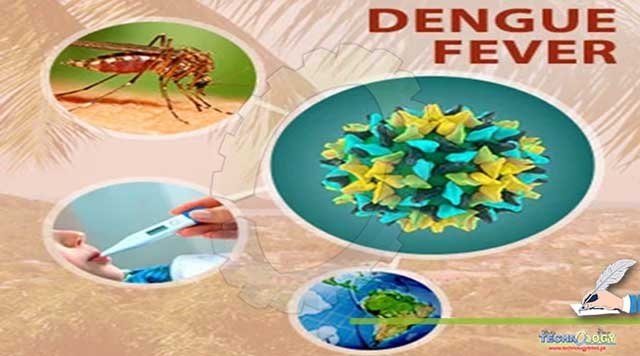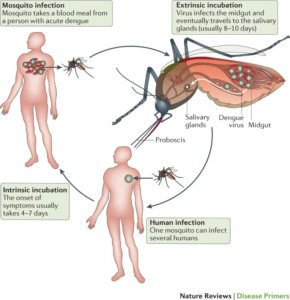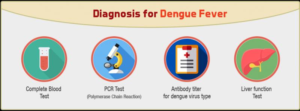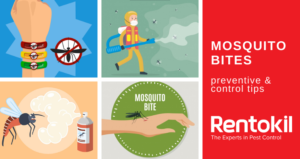Arthropod-borne diseases are one of the leading causes of mortality in humans especially those which are transmitted by the novel vector mosquito.

By Maria Kausar
Abstract
Mosquitoes are the vectors of many etiological agents that cause more than a million deaths annually that’s why they are constituting a severe scourge for the human population. Dengue is prevalent in more than one hundred states of the world. Nearly 40% population of the globe is at risk of getting dengue which makes dengue a fatal disease.
One of the most important diseases which is transmitted by the mosquito is Dengue fever. This mosquito-borne illness is of viral origin caused by the Dengue virus having four most commonly related viruses known as D1, D2, D3, and D4. That is the reason a person can get this infection four times in his lifespan. Dengue virus is spread through the bite of an Aedes mosquito. Aedes species are also involved in the spread of the Chikungunya virus, Zika virus, and many others.
This virus causes severe hemorrhages in addition to blood clots, seizures, damage to vital organs like the liver, spleen, and many more. The virus in its acute form causes high fever, joint aching, pain in the eyes, nasal or oral bleeding, and vomiting. Up till now, there is no specific treatment for dengue fever, however, a lot of fluid intake and analgesic use can help to immune from it. It can be controlled by controlling the mosquito population. This deadly virus causes the fatality of thousands of people every year. By avoiding mosquitoes bites, we can avoid this disease. Dengvaxia is the vaccine mostly used in the treatment of dengue worldwide including in Pakistan.
Introduction
Dengue is known by many other names such as breakbone fever or dandy fever. The very first case of dengue was reported in monkeys and it spread to humans almost a century ago. In the beginning, it was only present in African and Southeast Asian countries till the mid-period of the 20th century. Epidemics of dengue remained constant in these areas for a period of five to six months every year. But there was a periodic decrease and increase observed in the numeric figure of dengue infection due to the cyclic variation. According to WHO, in South Asia, the day-by-day increase in dengue & dengue-hemorrhagic fever has made it an endemic in this region. A current estimation shows that each year, about four hundred individuals become diseased from this novel virus and 20,000 people die annually due to its severe form. Periodic occurrence of dengue in the past few years with sporadic cases and the severe epidemic of dengue fever in 2011 in Pakistan has made it a Dengue endemic country.
Aedes mosquito cause transmission of dengue virus
Transmission
Primarily it is transmitted by the mosquito bite the mosquito of the Aedes species. The mosquito characteristically lays eggs on stagnant water in its vicinity. The mosquito directly takes viruses inside their bodies when they feed on an infected person. Viral transmission can occur from mother to child during pregnancy or at the time of giving birth.
Life cycle:
It is transmitted through the infected mosquito. The adult one lays eggs in the container having water in it. Eggs transformed into larvae during the favorable season. Larvae become pupae and it is also an aquatic stage. These pupae through the process of metamorphosis become adult mosquitoes and come outside from the pupal shell.

Diagnosis
Dengue causes several complications in the body of human beings. The most frequently observed signs and symptoms of dengue fever include nausea and vomiting with a high temperature, muscles and joints ache, rashes on the skin, and pain in eye and eye orbit. These symptoms remain for a minimum of two to a maximum of seven days. In healthy individuals, it takes a week to recover from this infection but immunocompromised patients go for its severe form. For the laboratory confirmation of the viral infection, dengue ELISA is in practice.

Differential diagnosis
Dengue fever must be differentiated from other diseases that present flu-like symptoms fever, retro-orbital headache, fatigue, joint aches or arthralgias, myalgias, vomiting, and lymphadenopathy.
Treatment:

As dengue fever is an infection of viral origin and not having any specific treatment for it. However, supportive therapy with the use of pain killers is effective in lowering its effect. But avoid the use of medicines like aspirin which dilute the blood and may support the bleeding. A vaccine known as Dengvaxia is offered to the high-risk populations and the individuals having a chance of re-infection.
Prevention:
To control the arbovirus infections host-vector relationship must be considered especially in terms of the vector immune system. As mosquito-borne diseases are the main threat to the global community causing both social and economic losses so, there is a need to minimize this load. The control of mosquitoes can be helpful in the control of the disease. Use of repellent against mosquitoes, wearing of dresses covering the full-body, installing of window and door screen to avoid mosquito entry inside your home is a good preventive step towards dengue fever. Do not self-medicate yourself but immediately consult a doctor if you feel any signs and symptoms of dengue. Control mosquito population inside and outside the home by discarding water storage bodies in your immediate locality.

Authors:
- Maria Kausar, M.Phil. Parasitology from University of Agriculture Faisalabad
- Dr. Muhammad Sohail Sajid, Chairman Dept. of Parasitology at University of Agriculture Faisalabad
- Arslan Nazim, DVM from University of Veterinary and Animal Sciences Lahore
- Rana M. Athar Ali, M.Phil. from University of Agriculture Faisalabad